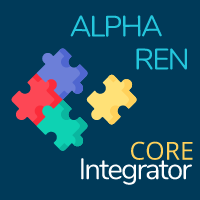 ALPHAREN CORE-Integrator (ARINT) System
ALPHAREN CORE-Integrator (ARINT) System
(c) 2021 RENware Software Systems. RESTRICTED only for project internal use
System Data and Objects
product version: 0.1
Table of contents:
Introductory
Naming rules
-
Objects
code-nameis not case sensitive and is a good rule to use always uppercase. The system will convert the data objectscode-nameto uppercase, even from the save step. -
New "user or client or implementation" level business objects
code-nameshould start with characterZ. Any other ARINT objects do not useZas first character in code-names, so this can make an acceptable separation of those objects that are subject of change by system updates and is a guarantee that objects starting withZin code-name will not be altered by any system update.
Object categories and models
Any data object must be in one of these categories:
-
entity - This is a relational data entity, more exactly a table to use the specific relational modeling concept. Such kind of objects are stored in relational system database.
-
json - This is an object can contain any data model and type that respect
JSONstandard. This kind of object can cover almost all kindNoSQL document typevariants. Such kind of object can be stored in any system database (relational or kv store) at your option. Default store place is kv system database. -
crypto_key - This kind of object contains keys used for cryptographic purposes. This kind of object is represented as a limited
jsontype (strict one level, no arrays, only string type keys). Acrypto_keyobject usually has one or two entries corresponding to one (in symmetrical cryptography) or two (in asymmetrical cryptography) keys, both as strings ofUTF-8characters (bytes). -
file - This kind of object is designed to keep files or directories references. This references are stored can be stored in any system database (relational or kv store) and must respect all Linux conventions regarding file names (directories are files too represented as convention with a
/character at end if is not obvious from context). So as a minimum strings ofUTF-8characters (bytes) no more than 256 characters (bytes)
As definition models the OO definition is preferred and for relational objects the SQL Alchemy is preferred option. For kv data the Python normal dictionaries can be used.
Namespaces catalog
Here are listed the main area of objects defined in System database. These are the equivalent of a namespace (or schema in relational databases terminology) and they will become in a way1 a prefix for all entities / objects contained in.
- URRM user roles and rights management
- ODEF business objects definition
- MADA global master data (cross any systems, applications, nodes, ie global for an ARINT instance)
- -#NOTE future reserved ...
Namespace URRM
URRM catalog
- -#NOTE future reserved ...
URRM_new_object_x
- -#NOTE future reserved ...
Namespace ODEF
ODEF catalog
- -#NOTE future reserved ...
ODEF_new_object_x
- -#NOTE future reserved ...
Namespace MADA
MADA catalog
-
OBTYPobject types and models. This contains values described of "Object types and models" section -
-#NOTE future reserved ...
MADA_new_object_x
- -#NOTE future reserved ...
Notes and remarks
-
(
PROPOSAL @ 230823 by piu): The way that concrete entities / objects are prefixed depends of database, ORM instrument used, etc. To keep as agnostic as possible this prefix will be used as object name prefix followed by_character. Allcode-names for a prefix will be kept in 4 characters. ↩